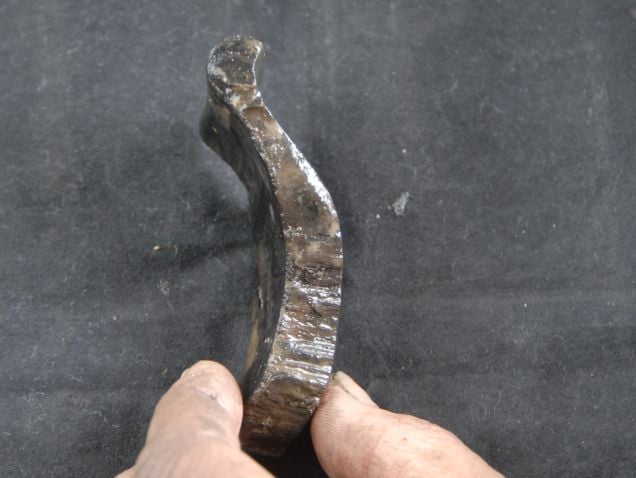Archaeologists Find 2,000-Year-Old Wooden Bowl, Strands of Hair in Northern Scotland
The Iron Age artifacts were sealed in a subterranean chamber of the Cairns Broch, a tower-like stone structure
/https://tf-cmsv2-smithsonianmag-media.s3.amazonaws.com/filer/c6/d4/c6d4ef1c-f973-4bf1-81fd-d08f432c28b6/dsc_0182-2.jpg)
During the Iron Age, the Cairns Broch—a tower-like stone building of monumental proportions—dominated the landscape of Windwick Bay, a rocky cove in the Scottish archipelago of Orkney. Equal parts house, fort and status symbol, the broch stood at the center of an ancient settlement until some point between the later 1st and mid-2nd century A.D., when it was sealed and subsequently abandoned.
Today, the broch continues to stand over the Cairns region of South Ronaldsay. This month, researchers from the University of the Highlands and Islands Archaeology Institute announced two singular discoveries made during ongoing excavations at the site: a 2,000-year-old wooden bowl likely used to serve food or drink, as well as strands of human hair dating to the same Iron Age period.
The Scotsman’s Alison Campsie reports that both the hair and bowl were found in “The Well,” a subterranean chamber of the broch. According to the UHI Archaeology Institute’s blog, the underground space is exceptionally well preserved, boasting an intact roof and stone-cut steps leading down into the heart of the chamber, which is filled with muddy silt. The chamber appears to have been sealed in an anaerobic state, or without oxygen, meaning that bacteria were unable to damage the items.
Given that the chamber was sealed around the same time the broch was abandoned, the archaeologists believe their finds date to the later 1st through mid-2nd century A.D.; however, they plan on conducting radiocarbon dating tests to determine if the items are even older than estimated.
Martin Carruthers, UHI lecturer and excavation director, tells Campsie that the team unearthed about 20 strands of hair, with more likely hidden in muddy soil samples still to be analyzed.
“It looks like human hair,” Carruthers says. “It is pliable, if you blow on it, it moves. It is shiny, dark and measures around [three to four inches] long, so potentially it records eight to 10 months of information about diet and the conditions people were living in.”
Although the team has previously recovered human remains—mainly teeth—from the site, the hair represents a unique opportunity to learn more about the lifestyle and health of the broch’s inhabitants. As Richard Gray wrote for the Telegraph while reporting on the discovery of 200,000-year-old hair back in 2009, soft tissue such as hair, skin and muscle typically doesn’t survive longer than a few hundred years.

In 2015, Kelly Knudson, an associate professor at Arizona State University who analyzed 2,000-year-old hair found on Peruvian mummies, further explained to New Historian’s Adam Steedman Thake that “we can use hair to look at diet because, quite simply, we are what we eat. By looking at how far the hair is from the scalp, we were able to look at what they were eating in particular weeks or months before they died.”
The Cairns archaeologists’ other significant find, the 2,000-year-old wooden bowl, is the oldest of its kind found in Orkney thus far. According to the Independent’s Chiara Giordano, the team has dubbed the bowl the “Cairns Cog” in honor of the region’s traditional wedding cog, an alcoholic drink passed around in a wooden vessel at marriage receptions.
“In appearance, the bowl is similar in shape to certain of the pottery vessels of the period, and in particular it looks like the sort of vessel we suspect to have been used for serving food or drink,” Carruthers explains in a statement. “Its round base makes you think that it would have been required to be constantly held when full, and perhaps used socially, passed around from hand to hand, person to person.”
The alderwood bowl measures nearly 12 inches across and features an outward-facing rim, globular body and rounded base. Although the bowl split at some point in its millenia-long history, it remained held together by the subterranean chamber’s muddy silts.
In addition to the bowl and hair, UHI archaeologists discovered an array of ancient artifacts at the Cairns site, from pieces of wood that mirror modern-day tent pegs to preserved plant fibers likely woven by human hands and a glass bead.
“There is still much work to do in The Well, and there are other amazing remains to be recovered from the silts there, as well as across the site,” the UHI blog states. “The excavations are ongoing and more waterlogged items are likely to be raised during that time. The next steps will be to conserve and assess the objects.”
/https://tf-cmsv2-smithsonianmag-media.s3.amazonaws.com/accounts/headshot/mellon.png)
/https://tf-cmsv2-smithsonianmag-media.s3.amazonaws.com/accounts/headshot/mellon.png)